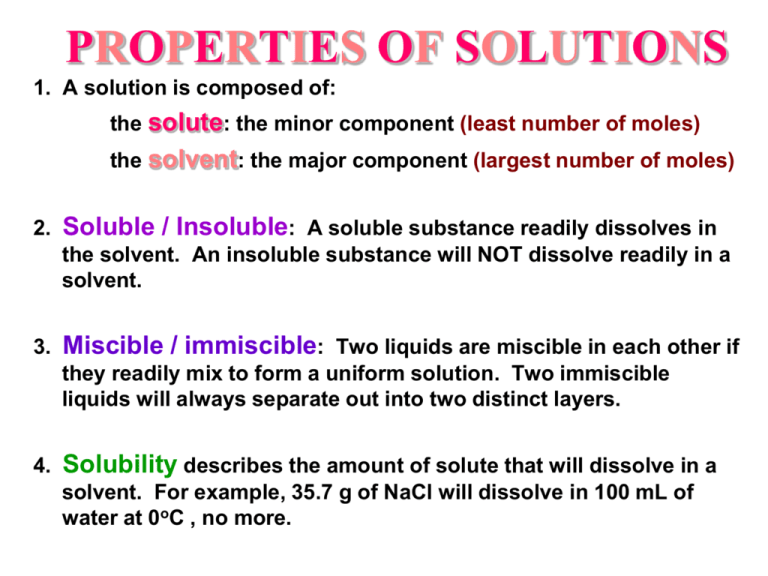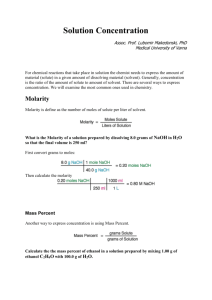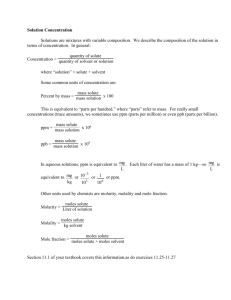Chap. 4 - Solution Chemistry
advertisement

PROPERTIES OF SOLUTIONS 1. A solution is composed of: the solute: the minor component (least number of moles) the solvent: the major component (largest number of moles) 2. Soluble / Insoluble: A soluble substance readily dissolves in the solvent. An insoluble substance will NOT dissolve readily in a solvent. 3. Miscible / immiscible: Two liquids are miscible in each other if they readily mix to form a uniform solution. Two immiscible liquids will always separate out into two distinct layers. 4. Solubility describes the amount of solute that will dissolve in a solvent. For example, 35.7 g of NaCl will dissolve in 100 mL of water at 0oC , no more. GENERAL PROPERTIES OF SOLUTIONS 1. A solution is a homogeneous mixture of two or more components. 2. It has variable composition. 3. The dissolved solute is molecular or ionic in size. 4. A solution may be either colored or colorless but is generally transparent. 5. The solute remains uniformly distributed throughout the solution and will not settle out through time. 6. The solute can be separated from the solvent by physical methods. What Happens When a Solute Dissolves? • there are attractive forces between the solute particles holding them together • there are also attractive forces between the solvent molecules • when we mix the solute with the solvent, there are attractive forces between the solute particles and the solvent molecules • if the attractions between solute and solvent are strong enough, the solute will dissolve 3 Table Salt Dissolving in Water Each ion is attracted to the surrounding water molecules and pulled off and away from the crystal When it enters the solution, the ion is surrounded by water molecules, insulating it from other ions The result is a solution with free moving charged particles able to conduct electricity Salt vs. Sugar Dissolved in Water ionic compounds dissociate into ions when they dissolve molecular compounds do not dissociate when they dissolve ELECTROLYTES Electrolytes are species which conducts electricity when dissolved in water. Acids, Bases, and Salts are all electrolytes. Salts and strong Acids or Bases form Strong Electrolytes. Salt and strong acids (and bases) are fully dissociated therefore all of the ions present are available to conduct electricity. HCl(s) + H2O H3O+ + ClWeak Acids and Weak Bases for Weak Electrolytes. Weak electrolytes are partially dissociated therefore not all species in solution are ions, some of the molecular form is present. Weak electrolytes have less ions avalible to conduct electricity. NH3 + H2O NH4+ + OH- Classes of Dissolved Materials MOLARITY A measurement of the concentration of a solution Molarity (M) is equal to the moles of solute (n) per liter of solution M = n / V = mol / L Calculate the molarity of a solution prepared by mixing 1.5 g of NaCl in 500.0 mL of water. How many grams of LiOH is needed to prepare 250.0 mL of a 1.25 M solution? What is the molarity of hydroiodic acid if the solution is 47.0% HI by mass and has a density of 1.50 g/mL? MOLARITY & DILUTION M 1 V1 = M 2 V2 The act of diluting a solution is to simply add more water (the solvent) thus leaving the amount of solute unchanged. Since the amount or moles of solute before dilution (nb) and the moles of solute after the dilution (na) are the same: nb = na And the moles for any solution can be calculated by n=MV A relationship can be established such that MbVb = nb = na = MaVa Or simply : MbVb = MaVa MOLARITY & dilution Given a 6.00 M HCl solution, how would you prepare 250.0 mL of 0.150 M HCl? M1 = 6.00 mol/L M2 = 0.150 V1 = ? mL V2 = 250.0 mL M 1 V1 = M 2 V 2 M2 V2 = V1 = (0.150 mol/L) (250.0 mL) = 6.25 mL of 6 M HCl M1 6.00 mol/L You would need 6.25 mL of the 6.00 M HCl reagent which would be added to about 100 mL of DI water in a 250.0 mL graduated cylinder then more water would be added to the mixture until the bottom of the menicus is at 250.0 mL. Mix well. Given a 3.50 M HBr solution, how would you prepare 834.5 mL of 0.0122 M HBr? Workshop on Molarity 1. Calculate the molarity of a solution made by dissolving 23.4 g of sodium sulfate in enough water to form 125 mL of solution. 2. Calculate the molarity of a solution made by dissolving 5.00 g of glucose in sufficient water to form 100 mL of solution. 3. How much 3.0 M H2SO4 would be required to make 500 mL of 0.10 M H2SO4? How much water must be added to the more concentrated solution to make the less concentrated solution? Workshop on Molarity 5. If 21.4 g of solid zinc are treated with 3.13 L 0.200 M HCl, how many grams of hydrogen gas will theoretically be formed? How much of which reactant will be left unreacted? The products of this reaction are hydrogen gas and zinc chloride. TITRATION Titration of a strong acid with a strong base ENDPOINT = POINT OF NEUTRALIZATION = EQUIVALENCE POINT At the end point for the titration of a strong acid with a strong base, the moles of acid (H+) equals the moles of base (OH-) to produce the neutral species water (H2O). If the mole ratio in the balanced chemical equation is NOT 1:1 then you must rely on the mole relationship and handle the problem like any other stoichiometry problem. MOLES OF ACID = MOLES OF BASE nacid = nbase Remember: M = n/V Acid-Base Titrations Acid-base titrations are an example of volumetric analysis, a technique in which one solution is used to analyze another. The solution used to carry out the analysis is called the titrant and is delivered from a device called a buret, which measures the volume accurately. The point in the titration at which enough titrant has been added to react exactly with the substance being determined is called the equivalence point (or stoichiometric point). This point is often marked by the change in color of a chemical called an indicator. The titration set-up is illustrated in the schematic shown above. 0 10 20 30 40 50 Acid-Base Titrations The following requirements must be met in order for a titration to be successful: 1. The concentration of the titrant must be known (called the standard solution). 2. The exact reaction between the titrant and reacted substance must be known. 3. The equivalence point must be known. An indicator that changes color at, or very near, the equivalence point is often used. 4. The point at which the indicator changes color is called the end point. The goal is to choose an indicator whose end point coincides with the equivalence point. NOTE: Equivalence Point End Point! WHY??? 5. The volume of titrant required to reach the equivalence point must be known (measured) as accurately as possible. Acid-Base Titrations When a substance being analyzed contains an acid, the amount of acid present is usually determined by titration with a standard solution containing hydroxide ions. The pH at certain points in the titration can be taken using different indicators, or alternatively, a pH meter can be used to give a readout of the exact pH. pH = - Log [H3O+] pH > 7 is referred to as a base pH < 7 is referred to as an acid Workshop on Titration: 1. What is the molarity of an NaOH solution if 48.0 mL is needed to neutralize 35.0 mL of 0.144 M H2SO4? 2. A sample of an iron ore is dissolved in acid, and the iron is converted to Fe+2. The sample is then titrated with 47.20 mL of 0.02240 M MnO4- solution. The oxidation-reduction reaction that occurs during titration is: 8H+(aq) + MnO4-(aq) + 5Fe+2(aq) Mn+2(aq) + 5Fe+3(aq) + H2O(l) A. How many moles of permanganate ion were added to the solution? B. How many moles of iron(II) ion were in the sample? C. How many grams of iron were in the sample? D. If the sample had a mass of 0.8890 g, what is the percentage of iron in the sample? GRAVIMETRIC ANALYSIS 1. Aluminum can be determined gravimetrically by reaction with a solution of 8-hydroxyquinoline (C9H7NO). A mass of 0.1248 g of Al(C9H7NO)3 was obtained by precipitating all of the Al3+ from a solution prepared by dissolving 1.8571 g of a mineral. What is the mass percent of aluminum in the mineral? GRAVIMETRIC ANALYSIS 2. You are given a solid that is a mixture of Na2SO4 and K2SO4. A 0.205 g sample of the mixture is dissolved in water. An excess of an aqueous solution of BaCl2 is added. The BaSO4 that is formed is filtered, dried, and weighted. Its mass is 0.298g. (a) What is the mass percent of sulfate ion in the sample? (b)(b) What is the percent composition by mass of Na2SO4 & K2SO4 in the sample? VOLUMETRIC ANALYSIS “REDOX TITRATION” 1. A person’s blood alcohol level can be determined by titrating a sample of blood plasma with potassium dichromate solution. 16H+ + 2 Cr2O72- + C2H5OH → 4 Cr3+ + 2 CO2 + 11 H2O If 35.46 mL of 0.05961 M Cr2O72- is required to titrate 28.00 g of plasma, what is the mass percent of alcohol in the blood? 2. The active agent in many hair bleaches is hydrogen peroxide. The amount of hydrogen peroxide in 13.8 g of hair bleach was determined by titration with a standard potassium permanganate solution. Unbalanced equation: MnO4- + H2O2 → O2 + Mn2+ a) Balance the above redox reaction in an acidic solution. b) How many grams of hydrogen peroxide were present in the 13.8 g sample of hair bleach if 43.2 mL of 0.105 M KMnO4 was needed to reach the endpoint?








